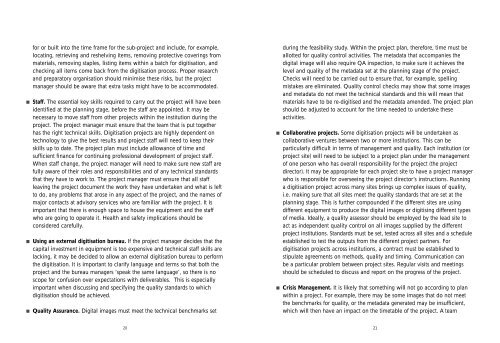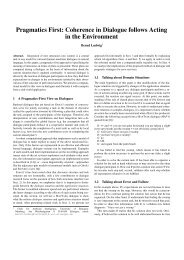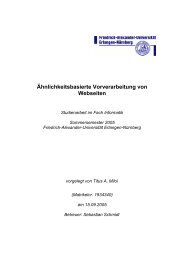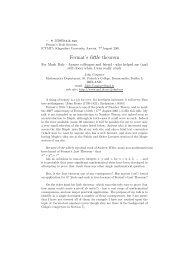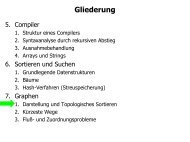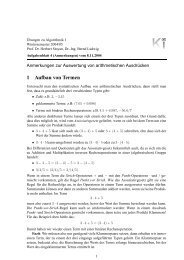Managing the Digitisation of Library, Archive and Museum Materials
Managing the Digitisation of Library, Archive and Museum Materials
Managing the Digitisation of Library, Archive and Museum Materials
Create successful ePaper yourself
Turn your PDF publications into a flip-book with our unique Google optimized e-Paper software.
for or built into <strong>the</strong> time frame for <strong>the</strong> sub-project <strong>and</strong> include, for example,<br />
locating, retrieving <strong>and</strong> reshelving items, removing protective coverings from<br />
materials, removing staples, listing items within a batch for digitisation, <strong>and</strong><br />
checking all items come back from <strong>the</strong> digitisation process. Proper research<br />
<strong>and</strong> preparatory organisation should minimise <strong>the</strong>se risks, but <strong>the</strong> project<br />
manager should be aware that extra tasks might have to be accommodated.<br />
■ Staff. The essential key skills required to carry out <strong>the</strong> project will have been<br />
identified at <strong>the</strong> planning stage, before <strong>the</strong> staff are appointed. It may be<br />
necessary to move staff from o<strong>the</strong>r projects within <strong>the</strong> institution during <strong>the</strong><br />
project. The project manager must ensure that <strong>the</strong> team that is put toge<strong>the</strong>r<br />
has <strong>the</strong> right technical skills. <strong>Digitisation</strong> projects are highly dependent on<br />
technology to give <strong>the</strong> best results <strong>and</strong> project staff will need to keep <strong>the</strong>ir<br />
skills up to date. The project plan must include allowance <strong>of</strong> time <strong>and</strong><br />
sufficient finance for continuing pr<strong>of</strong>essional development <strong>of</strong> project staff.<br />
When staff change, <strong>the</strong> project manager will need to make sure new staff are<br />
fully aware <strong>of</strong> <strong>the</strong>ir roles <strong>and</strong> responsibilities <strong>and</strong> <strong>of</strong> any technical st<strong>and</strong>ards<br />
that <strong>the</strong>y have to work to. The project manager must ensure that all staff<br />
leaving <strong>the</strong> project document <strong>the</strong> work <strong>the</strong>y have undertaken <strong>and</strong> what is left<br />
to do, any problems that arose in any aspect <strong>of</strong> <strong>the</strong> project, <strong>and</strong> <strong>the</strong> names <strong>of</strong><br />
major contacts at advisory services who are familiar with <strong>the</strong> project. It is<br />
important that <strong>the</strong>re is enough space to house <strong>the</strong> equipment <strong>and</strong> <strong>the</strong> staff<br />
who are going to operate it. Health <strong>and</strong> safety implications should be<br />
considered carefully.<br />
■ Using an external digitisation bureau. If <strong>the</strong> project manager decides that <strong>the</strong><br />
capital investment in equipment is too expensive <strong>and</strong> technical staff skills are<br />
lacking, it may be decided to allow an external digitisation bureau to perform<br />
<strong>the</strong> digitisation. It is important to clarify language <strong>and</strong> terms so that both <strong>the</strong><br />
project <strong>and</strong> <strong>the</strong> bureau managers ‘speak <strong>the</strong> same language’, so <strong>the</strong>re is no<br />
scope for confusion over expectations with deliverables. This is especially<br />
important when discussing <strong>and</strong> specifying <strong>the</strong> quality st<strong>and</strong>ards to which<br />
digitisation should be achieved.<br />
■ Quality Assurance. Digital images must meet <strong>the</strong> technical benchmarks set<br />
during <strong>the</strong> feasibility study. Within <strong>the</strong> project plan, <strong>the</strong>refore, time must be<br />
allotted for quality control activities. The metadata that accompanies <strong>the</strong><br />
digital image will also require QA inspection, to make sure it achieves <strong>the</strong><br />
level <strong>and</strong> quality <strong>of</strong> <strong>the</strong> metadata set at <strong>the</strong> planning stage <strong>of</strong> <strong>the</strong> project.<br />
Checks will need to be carried out to ensure that, for example, spelling<br />
mistakes are eliminated. Quality control checks may show that some images<br />
<strong>and</strong> metadata do not meet <strong>the</strong> technical st<strong>and</strong>ards <strong>and</strong> this will mean that<br />
materials have to be re-digitised <strong>and</strong> <strong>the</strong> metadata amended. The project plan<br />
should be adjusted to account for <strong>the</strong> time needed to undertake <strong>the</strong>se<br />
activities.<br />
■ Collaborative projects. Some digitisation projects will be undertaken as<br />
collaborative ventures between two or more institutions. This can be<br />
particularly difficult in terms <strong>of</strong> management <strong>and</strong> quality. Each institution (or<br />
project site) will need to be subject to a project plan under <strong>the</strong> management<br />
<strong>of</strong> one person who has overall responsibility for <strong>the</strong> project (<strong>the</strong> project<br />
director). It may be appropriate for each project site to have a project manager<br />
who is responsible for overseeing <strong>the</strong> project director’s instructions. Running<br />
a digitisation project across many sites brings up complex issues <strong>of</strong> quality,<br />
i.e. making sure that all sites meet <strong>the</strong> quality st<strong>and</strong>ards that are set at <strong>the</strong><br />
planning stage. This is fur<strong>the</strong>r compounded if <strong>the</strong> different sites are using<br />
different equipment to produce <strong>the</strong> digital images or digitising different types<br />
<strong>of</strong> media. Ideally, a quality assessor should be employed by <strong>the</strong> lead site to<br />
act as independent quality control on all images supplied by <strong>the</strong> different<br />
project institutions. St<strong>and</strong>ards must be set, tested across all sites <strong>and</strong> a schedule<br />
established to test <strong>the</strong> outputs from <strong>the</strong> different project partners. For<br />
digitisation projects across institutions, a contract must be established to<br />
stipulate agreements on methods, quality <strong>and</strong> timing. Communication can<br />
be a particular problem between project sites. Regular visits <strong>and</strong> meetings<br />
should be scheduled to discuss <strong>and</strong> report on <strong>the</strong> progress <strong>of</strong> <strong>the</strong> project.<br />
■ Crisis Management. It is likely that something will not go according to plan<br />
within a project. For example, <strong>the</strong>re may be some images that do not meet<br />
<strong>the</strong> benchmarks for quality, or <strong>the</strong> metadata generated may be insufficient,<br />
which will <strong>the</strong>n have an impact on <strong>the</strong> timetable <strong>of</strong> <strong>the</strong> project. A team<br />
20<br />
21


